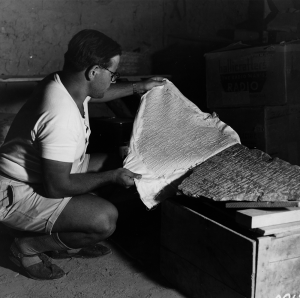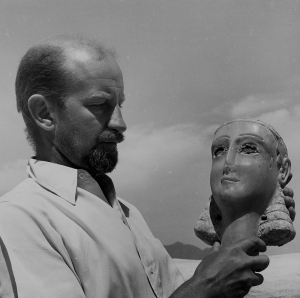
A new exhibit “Unearthing Arabia” at the Freer Sackler gallery displays many fascinating works from archaeological digs in South Arabia.
From 1950s Dodge Caravans bumping their way over sand dunes to spiders the size of human hands and jaw-dropping artifacts, the “Unearthing Arabia” exhibit at the Arthur M. Sackler Gallery has its fair share of Indiana Jones-like qualities.
The exhibit chronicles the archaeological work of prolific American explorer Wendell Phillips and his 1950-51 expedition to South Arabia (present-day Yemen). So why settle for watching “Raiders of the Lost Ark” when you can use that spare time to see genuine, unfamiliar and exciting relics in person at the Smithsonian?
A few years prior to the South Arabia expedition, Phillips took a research trip to Africa with the University of California.
“He got the [archaeology] bug there,” said Massumeh Farhad, who is the chief curator of Islamic art at the Sackler Gallery.” After that, it was the great passion of his life.”
In 1950, Phillips set off to excavate two old cities, Timna and Marib, home to the Queen of Sheba and a legendary incense trade. Before Phillips’ expedition, neither Timna nor Marib had been significantly excavated. His subsequent discoveries shaped much of the modern archeological field.
“He was adamant about scientifically recording everything and making sure that there were photographs and films and notes, [which] is really critical for understanding this area,” Farhad said.
“Unearthing Arabia” contains three central components: artifacts discovered on the expedition, artifacts of the expedition itself and video footage.
“We wanted to give a sense of what it was like to be on the expedition,” Farhad said.

This vantage point gives the viewer much more content to absorb than the average exhibit. You are not only witnessing the amazing artifacts but also the photos, journals, cameras and footage straight from the archeologist and his accompanying team. The exhibit begins to feel like an expedition in itself as the viewer continues to uncover additional treasures, from alabaster busts to intricately decorated gold necklaces. The records and remnants of Phillips’ historic travels are just as mesmerizing as the ancient artifacts he uncovered, many of which are still in mint condition.
The exhibit also focuses on the inscriptions of numerous artifacts that were subsequently decoded by Fr. Albert Jamme during the expedition. Such inscriptions adorn necklaces, tools and sections of decoratively carved walls throughout “Unearthing Arabia.” The presence of this ancient South Arabic script on the artifacts, which is undeniably beautiful, also holds important implications for modern understandings of the Arabic language.
“[Phillips] has really laid the groundwork for subsequent expeditions in the whole Arabian Peninsula, [for example] the study of inscriptions, which are really important in that area because there are so many different languages and scripts,” Farhad said.
On the longest continuous wall of the exhibit space, footage from the expedition tells the tale from start to finish. Instead of the usual museum video, which can be a bit dry, the Phillips footage plays like a movie. Even though it’s from the 1950s, the film was pristinely preserved so that the quality is incredible. It’s especially exciting to see the camera pan over piles of artifacts in the excavation site in 1950 South Arabia before turning around to see those very artifacts mounted on the opposite wall.
The use of original footage in “Unearthing Arabia” breaks the typical barrier in museums between the artifact and everything that led up to its presence in the exhibit. It makes the alabaster statues from the first century seem accessible and understandable in a way that is both fantastical and factual.
The significance of Phillips’ contributions to modern understandings of archaeology cannot be understated. According to Farhad, “Nothing could be done without referring back to the work of Wendell Phillips and his team.”
The structure of the exhibit as an expedition itself, combined with the sheer magnitude of Phillips’ discoveries, creates a singular artistic experience. “Unearthing Arabia” meets the viewer at the intersection of history, art, religion and adventure. The gravity of Phillips’ explorations truly leaves a lasting impression and undoubtedly inspires the Indiana Jones in all of us.


















